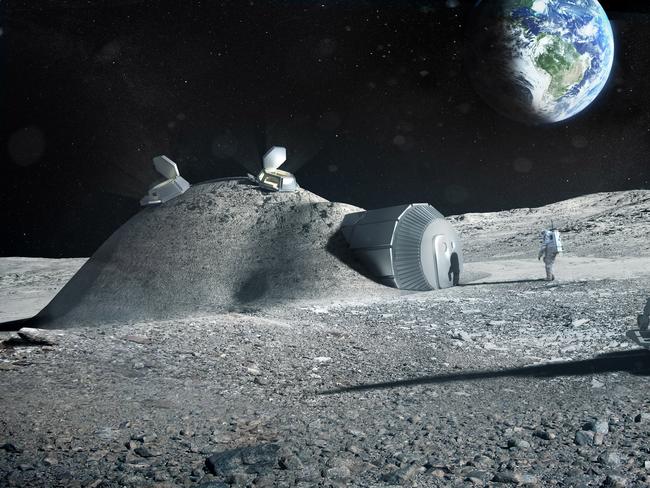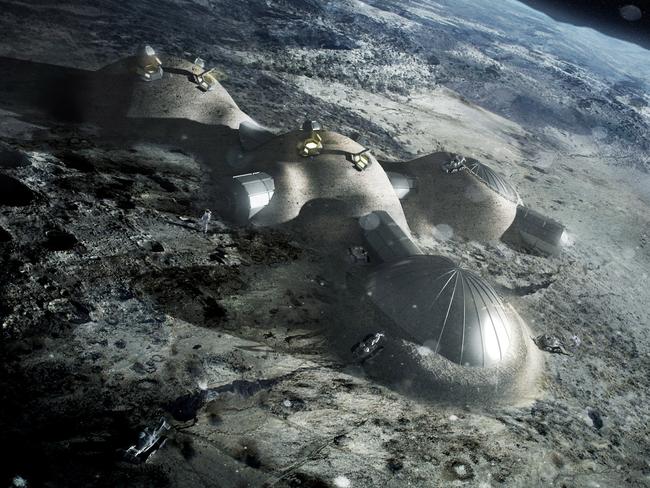NASA wants robots to mine the Moon for fuel to send humans to Mars
ON the 46th anniversary of the Moon landings, NASA says it wants to build a stepping stone base to Mars there. How? With terraforming robots.
ON the 46th anniversary of the Moon landings, NASA says it wants to build a stepping stone base to Mars there. How? Perhaps with terraforming robots.
The idea is ambitious: Put people back on the Moon by 2021. And have them living up there by the 2030s.
Why? To save NASA billions of dollars in recurring launch costs.
How? By mining ice buried in the dark depths of Moon craters and converting it into rocket fuel.
Apollo's path sent humans to the moon. We're extending that path to asteroids, Mars & beyond: http://t.co/Y502nYoPTa pic.twitter.com/qnKtV9W178
— NASA (@NASA) July 20, 2015This would dramatically reduce the need to build enormous, fuel-hungry rockets to lift cargoes out of Earth orbit. At the moment, private contractor SpaceX charges NASA $6400 for every kilogram it blasts into space.
Under the new proposal, cargoes could be sent to the Moon on much smaller and cheaper boosters, have their fuel-tanks topped-up, and continue on their way to Mars.
SOLAR SYSTEM 2.0: We’ve found over 400 stars with worlds, but only one is like ours
This project should also be done as a NASA — private enterprise partnership, the NexGen study recommends.
But how do you build a base on the Moon without budget-breaking costs?
NASA has been seriously considering getting robots to do all the hard work for them.

ROBOT ‘TERRAFORMING’ ARMY
Last month it announced funding for a $500,000, two-year study proposing to send robots (named TransFormers) to the Lunar south pole to “terraform” the 209sq/km Shackleton Crater.
http://www.nasa.gov/feature/trans-formers-for-lunar-extreme-environments-ensuring-long-term-operations-in-regions-of
Water ice has already been detected in its depths.
The idea is to drop a workforce of robots around the crater’s 4.2km high rim where they will erect a series of enormous mirrors.
These will reflect sunlight down to the ice below.
Why?

To power more robots as they slave away constructing the desired processing facilities.
The reflected solar energy is not just a vital fuel source: It also will keep the industrious machines from freezing solid in the -173C conditions.
As the workforce moves, so too will the TransFormers: They will retract their 40 metre diameter mirrors, shift along the rim, extend them again — and refocus their beam of sunlight where it is needed.
Due to their height, there is always some point on the peaks under full sunlight.
A single reflector is expected to be able to beam about a megawatt of energy into the 6km deep crater to power one industrial-strength rover — or several Mars Curiosity-sized explorers.
The challenge is to fold one such reflector into a 1 metre square cube weighing no more than 100kg.
What will the industrial bots be doing below?

3D PRINTED MOONBASE
The European Space Agency late last year said its vision of humanity’s future on the Moon included robot-printed domed homes.
The idea is to land robotic 3D printers where they are most needed. These — and their robotic minions — wills sweep up the Moon dust as the raw material for their building projects.
Chief among these packed-dust construction projects would be an igloo-like domed home for up to four astronauts.
Moon dust, it appears, has a multitude of advantages over assembling prefabricated huts.

First, and most obvious, is cost: There is no need to blow $6500 lifting every kilogram of fibre board out of orbit.
But the compacted dust also offers important insulation against extreme swings in Lunar temperature and bursts of radiation coming from the Sun.
It’s all just an idea at the moment. Unlike NASA’s TransFormer reflector robots, this one hasn’t yet received further funding.




